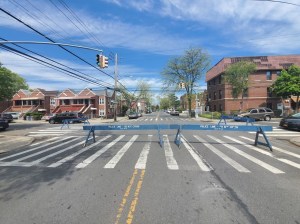Bronx Pol Mark Gjonaj Takes Victory Lap In Stopping Morris Park Avenue ‘Road Diet’

The Bronx is burning.
Business owners along Morris Park Avenue — led by anti-street safety Council Member Mark Gjonaj — will take a victory lap this morning over city officials after winning a court order that will halt the Department of Transportation’s safety redesign of a roadway where 426 pedestrians and cyclists have been injured, with one fatality, since 2010.
“Despite broad community opposition, the city recently announced that it planned to begin implementing its Vision Zero initiative for Morris Park Avenue starting on April 29 without addressing valid concerns of local residents,” Gjonaj said in a statement on Friday. “The court ruling represents a victory for local residents who stand against the city’s top-down ‘City Hall knows best’ approach [and] refusal to engage community on valid concerns.”
Those “valid” concerns appear to be that the so-called “road diet” plan — which would tame speedway-like conditions by reducing the roadway from two lanes in each direction to one, with turning bays to reduce congestion— would make it more difficult for residents and delivery trucks to unsafely double-park.
Gjonaj had said as much at a council hearing on Monday.
“In a perfect world we’d have adequate parking spaces driving lanes, bus lanes, bike lanes, sidewalks, handicapped parking — but this is not a perfect world,” he said. “Parking and delivery of commercial vehicles is as integral to this city as the MTA. And the problem that we have … just finding space to make a delivery. And I’ll use a perfect example: Vision Zero. It’s taking two lanes, road diet, making into one lane and a bike lane, with only a small place for commercial trucks to park. … It’s impossible to meet the demands of those commercial properties! Impossible for those suppliers to get to those merchants. But what will happen is those trucks will have to double park, forcing vehicles to either come to a dead halt and create congestion or they have to use side streets or they have to risk a head on collision to drive over the markings. I have to stick up for our business owners. Those delivery trucks are hard working New Yorkers meeting the needs and demands of our small businesses.”
On Thursday, a Bronx judge issued a temporary restraining order barring the city from beginning the work. Neither Gjonaj nor the city Law Department made the ruling available, but Law Department spokesman Nick Paolucci said, “The court has not fully weighed in on the merits of these claims. We stand by this carefully thought out project which will save lives, and we will mount a vigorous defense.”
Officials have denied the substance of the lawsuit — that Vision Zero is somehow illegal because it was not statutorily created, but is a set of connected policies that the de Blasio administration created. That said, the city is under court order to make roadways safer, thanks to a 2017 ruling that that New York City and other municipalities can be held liable for failing to redesign streets with a history of traffic injuries and reckless driving.
Gjonaj dismissed that in a brief conversation with Streetsblog, saying the Bronx business owners’ lawsuit stemmed from the city’s decision to ignore local opposition for the plan, which would redesign the roadway between Adams Street and Newport Avenue. [PDF]

“You have to take into consideration the impact and need,” he said. ‘There is major community opposition. The Community Board unanimously voted against it. There was a town hall. The stakeholders have voiced their opinion and fallen on deaf ears. We have a window company owner who says he’ll go out of business if this plan is implemented.”
The city has implemented such four-to-two road diets along fast-moving stretches in all five boroughs. Businesses rarely suffer.
Most important is safety. The long-overdue traffic-calming improvement “reduces speeding … creates safer left turns, encourages slower speeds 24 hours a day … make[s] pedestrians more visible to drivers [and] minimize[s] double parking on a retail corridor,” the DOT said in a statement.
Gjonaj and CB11 are willfully ignoring that city traffic calming projects have consistently improved safety. On commercial Vanderbilt Avenue between Grand Army Plaza and Atlantic Avenue in Brooklyn, DOT says injuries fell by 15 percent. On Macombs Road between University and Jerome avenues in The Bronx, injuries dropped by 41 percent. On Jewel Avenue between 164th and Main streets in Queens, a four-lanes-to-two-lanes conversion reduced injuries by 37 percent, city statistics show.
“In 2009, we did a similar conversion on Allerton Avenue from East Gun Hill Road to Boston Road and pedestrian injuries are down 50 percent there,” DOT’s Bronx Borough Commissioner Nivardo Lopez told Streetsblog earlier this year.
The challenge for transportation planners, Lopez added, is that so-called road diets are counterintuitive if your opinion of how roads should work is formed from behind the wheel of a car.
“They see four travel lanes becoming two and they think it will make traffic worse,” Lopez said. “For most people, that’s their concern because, fortunately, most people are not hit by a vehicle or are involved in a crash. Safety is out of sight, out of mind for them. To them being stuck in traffic is more relatable.”
City officials declined to comment on Gjonaj’s victory lap.




